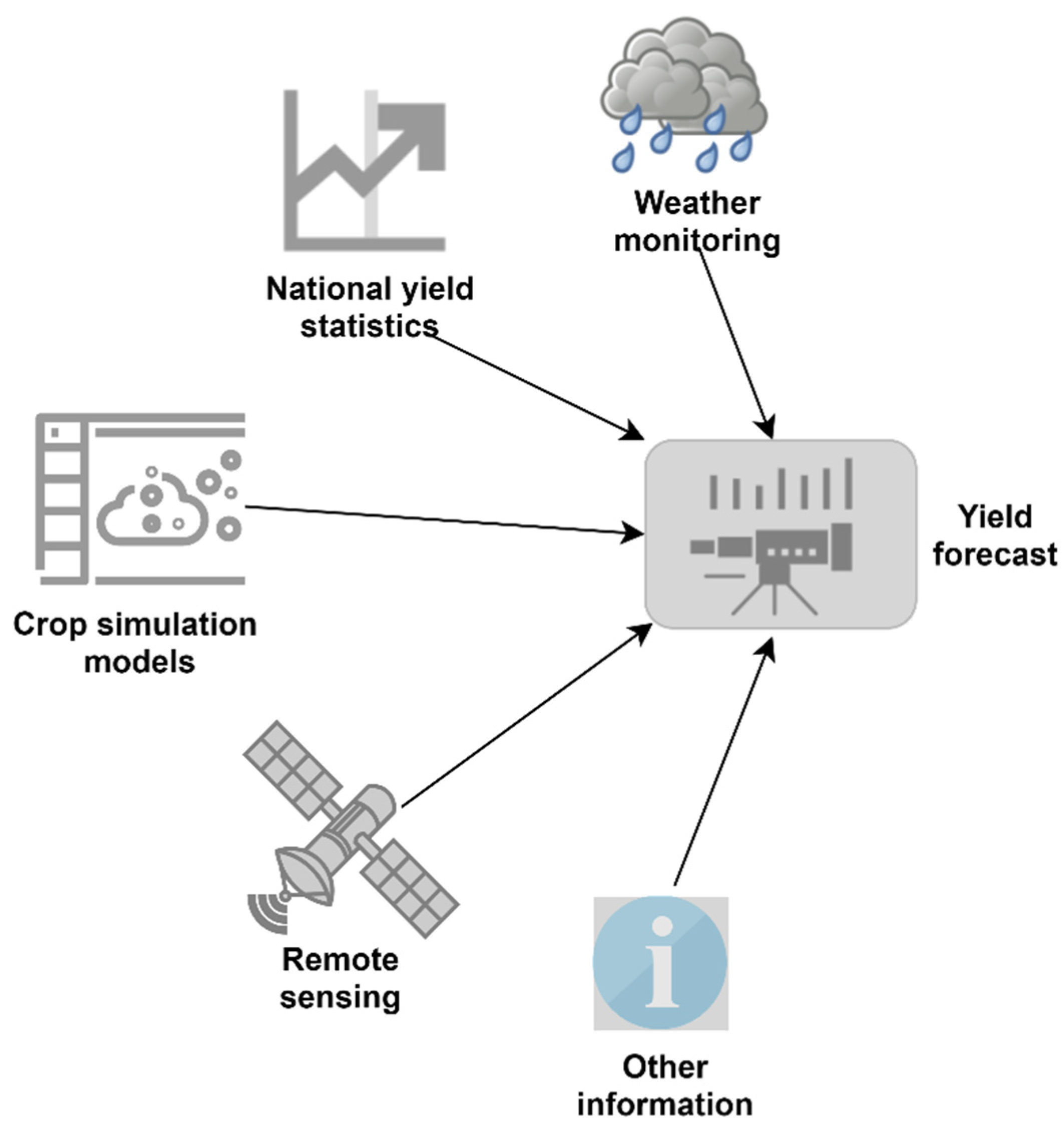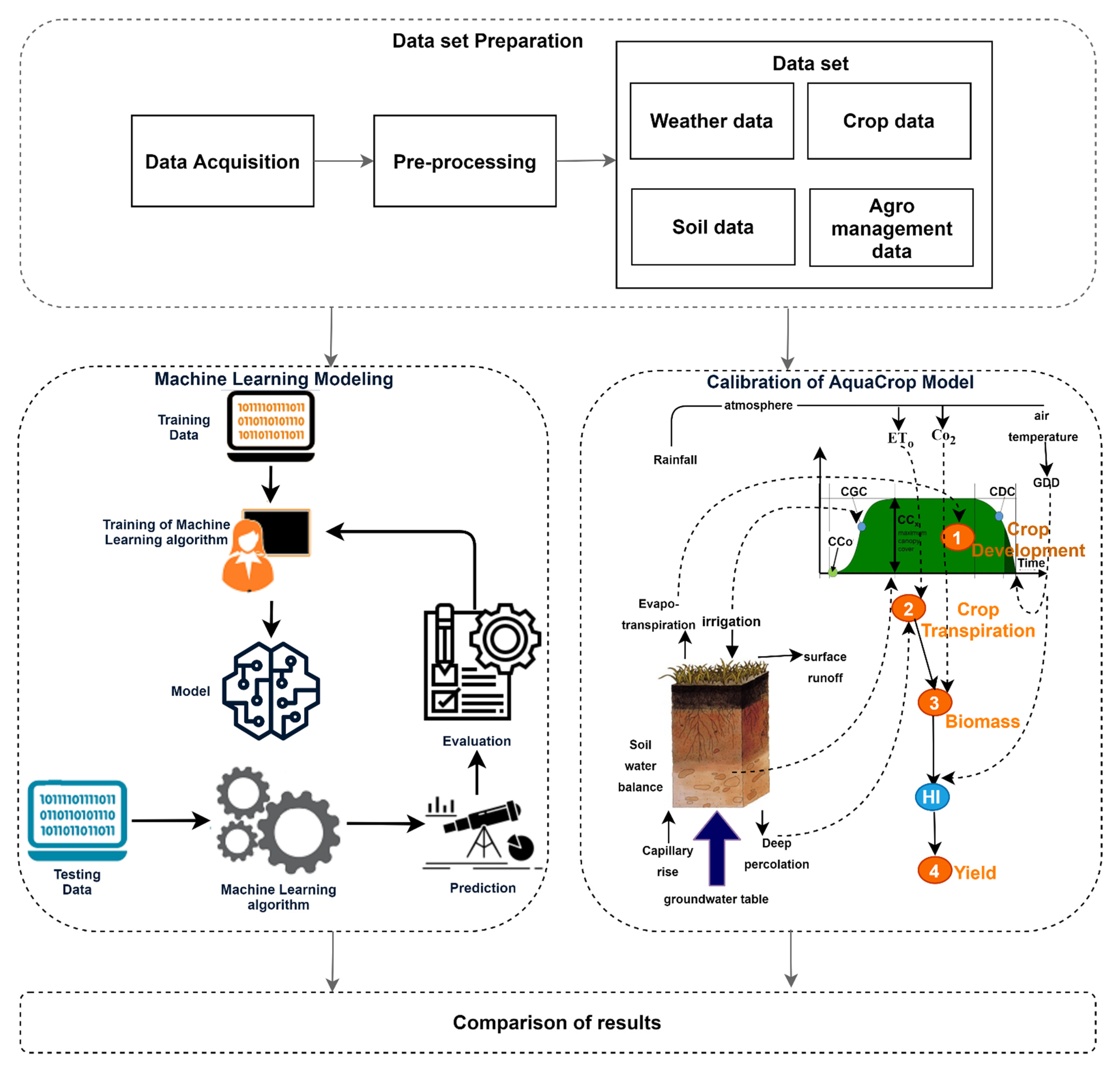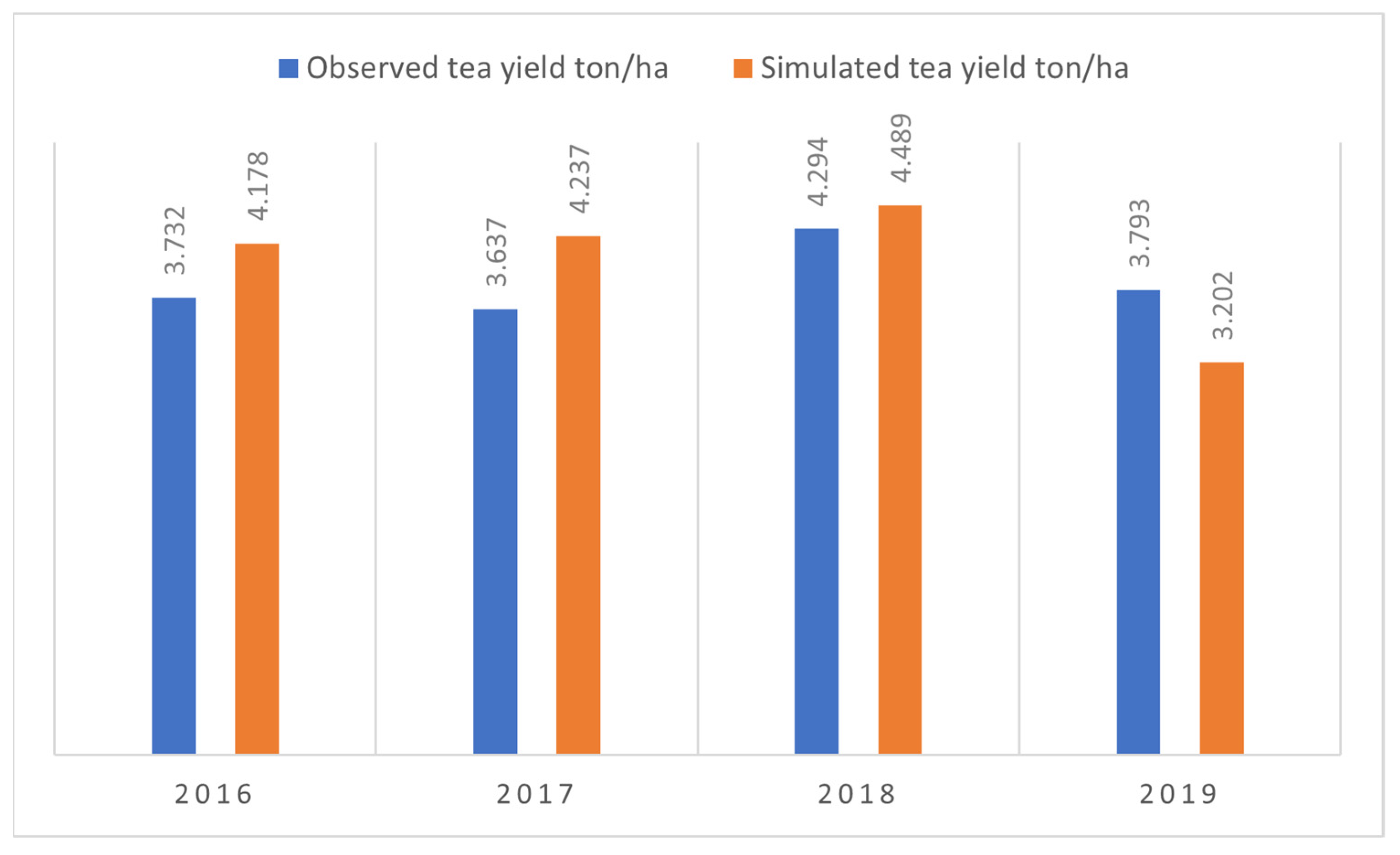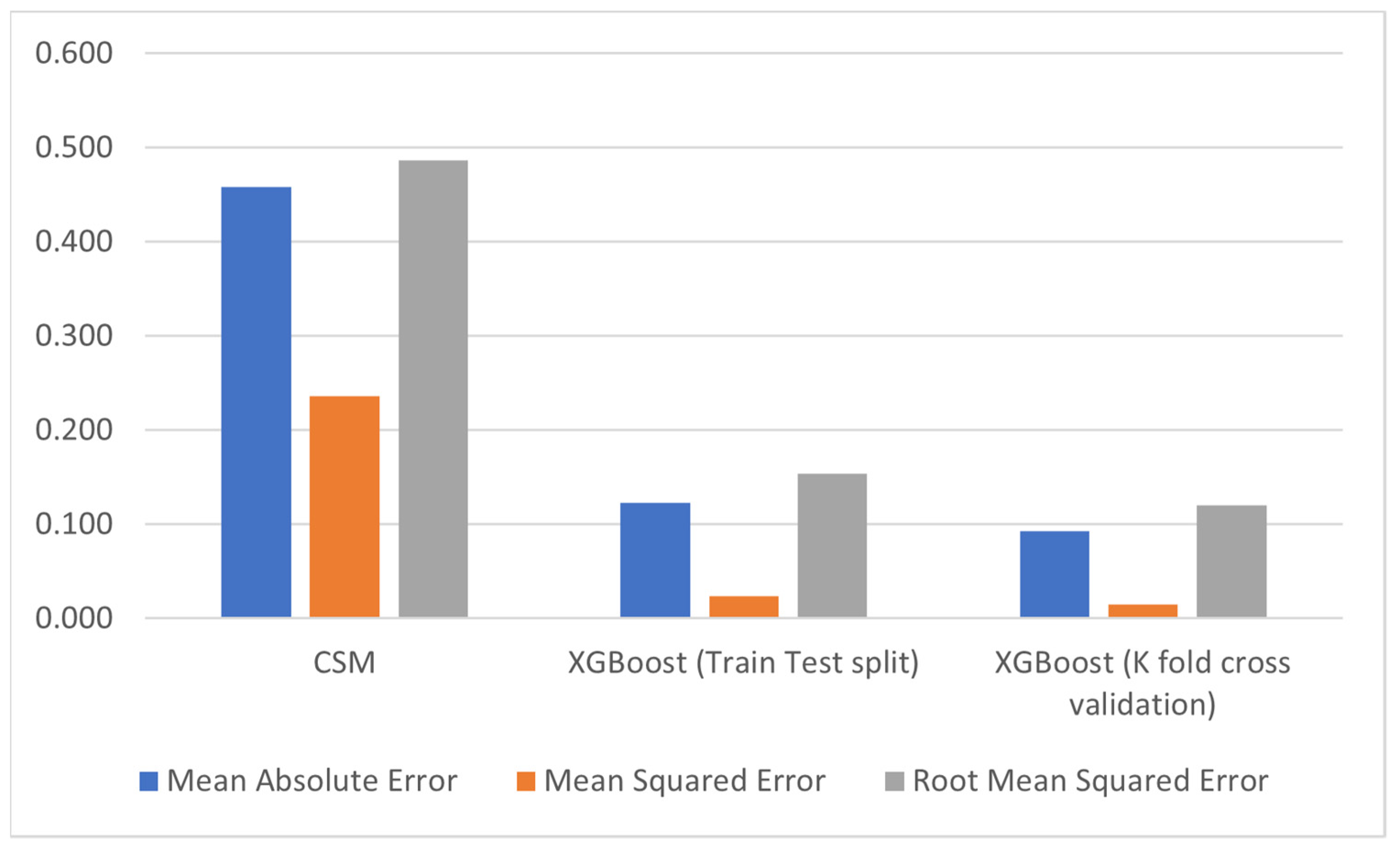A Hybrid Approach to Tea Crop Yield Prediction Using Simulation Models and Machine Learning
Abstract
1. Introduction
- (1)
- How to calibrate the selected CSM?
- (2)
- How do ML regression algorithms perform for tea yield prediction?
- (3)
- Which technique from both ML and CSM performs better for tea yield prediction?
2. Review of Existing Methods
3. Methodology
3.1. Study Area
3.1.1. Data
3.1.2. Pre-Processing
Weather Data
Soil Data
Crop Data
Agro-Management Data
3.2. Methods Implementation
3.2.1. Estimation of Tea Yield Based on the FAO AquaCrop Model
3.2.2. Estimation of Tea Yield Using ML Techniques
- (a)
- Linear SVR
- (b)
- AdaBoost Regressor
- (c)
- Automatic Relevance Determination (ARD) Regression
- (d)
- Decision Tree Regressor
- (e)
- Multilayer Perceptron (MLP) Regressor
- (f)
- Multiple Linear Regression (MLR)
- (g)
- Random Sample Consensus Regressor
- Generating a hypothesis from a random sample of data (hypothesis generation)
- Verifying it with other data (hypothesis evaluation)
- (h)
- Simple Linear Regression (SLR)
- (i)
- XGBOOST
- (j)
- SVM Regressor
Training and Testing
10-Fold Cross-Validation
4. Results and Discussion
4.1. Evaluation of the AquaCrop Model
AquaCrop Model Calibration and Validation
4.2. Evaluation of ML Techniques
4.2.1. Train Test Split
4.2.2. 10-Fold Cross-Validation
4.3. Comparison of the ML and AquaCrop Model for Predicting Tea Yield
5. Conclusions
Author Contributions
Funding
Institutional Review Board Statement
Informed Consent Statement
Data Availability Statement
Acknowledgments
Conflicts of Interest
References
- Kumar, H.V.; Chauhan, N.; Patel, D.; Patel, J. Predictive factors to avoid farming as a livelihood. J. Econ. Struct. 2019, 8, 10. [Google Scholar] [CrossRef]
- Azam, A.; Shafique, M. Agriculture in Pakistan and its Impact on Economy—A Review. Int. J. Adv. Sci. Technol. 2017, 103, 47–60. [Google Scholar] [CrossRef]
- Rehman, A.; Jingdong, L.; Shahzad, B.; Chandio, A.A.; Hussain, I.; Nabi, G.; Iqbal, M.S. Economic perspectives of major field crops of Pakistan: An empirical study. Pac. Sci. Rev. B Humanit. Soc. Sci. 2015, 1, 145–158. [Google Scholar] [CrossRef]
- Chandio, A.A.; Yuansheng, J.; Magsi, H. Agricultural sub-sectors performance: An analysis of sector-wise share in agriculture GDP of Pakistan. Int. J. Econ. Financ. 2016, 8, 156–162. [Google Scholar] [CrossRef]
- Chaudhry, A.F.; Butt, A.R.; Chani, M.I. Long-run relationship between exports and imports of Pakistan. Int. J. Econ. Financ. 2017, 9, 204–211. [Google Scholar] [CrossRef][Green Version]
- Situation, C.M.; Medium, T.O. Current Market Situation and Medium Term Outlook for tea to 2027 In Proceedings of the Intergovernmental Group on Tea-Twenty-Third Session. Hangzhou, China, 17–20 May 2018; pp. 17–20. [Google Scholar]
- FAO. World Food and Agriculture—Statistical Pocketbook; FAO: Rome, Italy, 2018. [Google Scholar]
- Hamid, F.S.; Khan, S.; Siddiq, M.; Zaman, Q.U.; Shah, B.H.; Yazdan, F.; Khan, M.A. Tea cultivation in Pakistan: Problems and future prospects. Eur. Acad. Res. 2016, 4, 5555–5562. [Google Scholar]
- Latif, A.; Jan, A.U.; Chishti, A.F.; Fayaz, M.; Hamid, F.S. Assessing potential of local tea production in pakistan. Sarhad J. Agric. 2008, 24, 340–343. [Google Scholar]
- Sagar, B.; Cauvery, N. Agriculture Data Analytics in Crop Yield Estimation: A Critical Review. Indones. J. Electr. Eng. Comput. Sci. 2018, 12, 1087–1093. [Google Scholar] [CrossRef]
- You, J.; Li, X.; Low, M.; Lobell, D.; Ermon, S. Deep gaussian process for crop yield prediction based on remote sensing data. In Proceedings of the Thirty-First AAAI Conference on Artificial Intelligence, San Francisco, CA, USA, 4–9 February 2017; pp. 4559–4565. [Google Scholar]
- Kuwata, K.; Shibasaki, R. Estimating crop yields with deep learning and remotely sensed data. In Proceedings of the 2015 IEEE International Geoscience and Remote Sensing Symposium (IGARSS), Milan, Italy, 26–31 July 2015; pp. 858–861. [Google Scholar]
- Hammer, R.G.; Sentelhas, P.C.; Mariano, J.C. Sugarcane Yield Prediction through Data Mining and Crop Simulation Models. Sugar Tech. 2020, 22, 216–225. [Google Scholar] [CrossRef]
- Yadav, S.; Misra, A.; Mishra, S.; Pandey, V. Crop growth simulation models (InfoCrop v. 2.1, DSSATv4. 5, WOFOSTv1. 5 and Cropsytv 4.19) software. Water Energy Secur. Arena Clim. Chang. 2018, 34, 456–469. [Google Scholar]
- Kern, A.; Barcza, Z.; Marjanović, H.; Árendás, T.; Fodor, N.; Bónis, P.; Bognár, P.; Lichtenberger, J. Statistical modelling of crop yield in Central Europe using climate data and remote sensing vegetation indices. Agric. For. Meteorol. 2018, 260, 300–320. [Google Scholar] [CrossRef]
- Lobell, D.B.; Burke, M.B. On the use of statistical models to predict crop yield responses to climate change. Agric. For. Meteorol. 2010, 150, 1443–1452. [Google Scholar] [CrossRef]
- Crane-Droesch, A. Machine learning methods for crop yield prediction and climate change impact assessment in agriculture. Environ. Res. Lett. 2018, 13, 114003. [Google Scholar] [CrossRef]
- Beringer, T.; Kulak, M.; Müller, C.; Schaphoff, S.; Jans, Y. First process-based simulations of climate change impacts on global tea production indicate large effects in the world’s major producer countries. Environ. Res. Lett. 2020, 15, 034023. [Google Scholar] [CrossRef]
- Bai, T.; Zhang, N.; Chen, Y.; Mercatoris, B. Assessing the performance of the wofost model in Simulating jujube fruit Tree growth under different irrigation regimes. Sustainability 2019, 11, 1466. [Google Scholar] [CrossRef]
- Er-Raki, S.; Bouras, E.; Rodriguez, J.; Watts, C.; Lizarraga-Celaya, C.; Chehbouni, A. Parameterization of the AquaCrop model for simulating table grapes growth and water productivity in an arid region of Mexico. Agric. Water Manag. 2020, 245, 106585. [Google Scholar] [CrossRef]
- De Costa, W.; Mohotti, A.J.; Wijeratne, M.A. Ecophysiology of tea. Braz. J. Plant Physiol. 2007, 19, 299–332. [Google Scholar] [CrossRef]
- Kabir, S. A study on ecophysiology of tea (Camellia sinensis) with special reference to the influence of climatic factors on physiology of a few selected tea clones of Darjeeling. Int. Tea Sci. 2001, 1, 1–9. [Google Scholar]
- Upadhyaya, H.; Panda, S. Antioxidant Efficiency and Biochemical Variations in Five Clones of Camelia sinensis L. Physiol. Mol. Biol. Plants 2004, 10, 115–120. [Google Scholar]
- Ahmed, S.; Stepp, J.R.; Orians, C.; Griffin, T.; Matyas, C.; Robbat, A.; Cash, S.; Xue, D.; Long, C.; Unachukwu, U. Effects of extreme climate events on tea (Camellia sinensis) functional quality validate indigenous farmer knowledge and sensory preferences in tropical China. PLoS ONE 2014, 9, e109126. [Google Scholar] [CrossRef]
- Wijeratne, M.; Anandacoomaraswamy, A.; Amarathunga, M.; Ratnasiri, J.; Basnayake, B.; Kalra, N. Assessment of impact of climate change on productivity of tea (Camellia sinensis L.) plantations in Sri Lanka. J. Natl. Sci. Found. Sri Lanka 2007, 35, 119–126. [Google Scholar] [CrossRef]
- Gunathilaka, R.D.; Smart, J.C.; Fleming, C.M. The impact of changing climate on perennial crops: The case of tea production in Sri Lanka. Clim. Chang. 2017, 140, 577–592. [Google Scholar] [CrossRef]
- Hong, N.B.; Yabe, M. Improvement in irrigation water use efficiency: A strategy for climate change adaptation and sustainable development of Vietnamese tea production. Environ. Dev. Sustain. 2017, 19, 1247–1263. [Google Scholar] [CrossRef]
- Sitienei, B.J.; Juma, S.G.; Opere, E. On the use of regression models to predict tea crop yield responses to climate change: A case of Nandi East, sub-county of Nandi county, Kenya. Climate 2017, 5, 54. [Google Scholar] [CrossRef]
- Becker-Reshef, I.; Vermote, E.; Lindeman, M.; Justice, C. A generalized regression-based model for forecasting winter wheat yields in Kansas and Ukraine using MODIS data. Remote Sens. Environ. 2010, 114, 1312–1323. [Google Scholar] [CrossRef]
- Qader, S.H.; Dash, J.; Atkinson, P.M. Forecasting wheat and barley crop production in arid and semi-arid regions using remotely sensed primary productivity and crop phenology: A case study in Iraq. Sci. Total Environ. 2018, 613, 250–262. [Google Scholar] [CrossRef]
- Kaul, M.; Hill, R.L.; Walthall, C. Artificial neural networks for corn and soybean yield prediction. Agric. Syst. 2005, 85, 1–18. [Google Scholar] [CrossRef]
- Paudel, D.; Boogaard, H.; de Wit, A.; Janssen, S.; Osinga, S.; Pylianidis, C.; Athanasiadis, I.N. Machine learning for large-scale crop yield forecasting. Agric. Syst. 2021, 187, 103016. [Google Scholar] [CrossRef]
- Khaki, S.; Wang, L. Crop yield prediction using deep neural networks. Front. Plant Sci. 2019, 10, 621. [Google Scholar] [CrossRef]
- Van Ittersum, M.; Donatelli, M. Modelling cropping systems: Highlights of the symposium and preface to the special issues. Eur. J. Agron. 2003, 18, 187–197. [Google Scholar] [CrossRef]
- Kasampalis, D.A.; Alexandridis, T.K.; Deva, C.; Challinor, A.; Moshou, D.; Zalidis, G. Contribution of remote sensing on crop models: A review. J. Imaging 2018, 4, 52. [Google Scholar] [CrossRef]
- Batchelor, W.D.; Basso, B.; Paz, J.O. Examples of strategies to analyze spatial and temporal yield variability using crop models. Eur. J. Agron. 2002, 18, 141–158. [Google Scholar] [CrossRef]
- Tao, F.; Rötter, R.P.; Palosuo, T.; Gregorio Hernández Díaz-Ambrona, C.; Mínguez, M.I.; Semenov, M.A.; Kersebaum, K.C.; Nendel, C.; Specka, X.; Hoffmann, H. Contribution of crop model structure, parameters and climate projections to uncertainty in climate change impact assessments. Glob. Chang. Biol. 2018, 24, 1291–1307. [Google Scholar] [CrossRef] [PubMed]
- Kang, Y.; Özdoğan, M. Field-level crop yield mapping with Landsat using a hierarchical data assimilation approach. Remote Sens. Environ. 2019, 228, 144–163. [Google Scholar] [CrossRef]
- Guerra, L.; y Garcia, A.G.; Hook, J.; Harrison, K.; Thomas, D.; Stooksbury, D.; Hoogenboom, G. Irrigation water use estimates based on crop simulation models and kriging. Agric. Water Manag. 2007, 89, 199–207. [Google Scholar] [CrossRef]
- Mote, B.; Vasani, M.; Ahir, H.; Yadav, S.; Pandey, V. Simulation of phenology and yield attributing characters of legume crops using DSSAT and InfoCrop Model. Adv. Life Sci. 2016, 5, 5265–5271. [Google Scholar]
- Li, H.; Chen, Z.; Liu, G.; Jiang, Z.; Huang, C. Improving winter wheat yield estimation from the CERES-wheat model to assimilate leaf area index with different assimilation methods and spatio-temporal scales. Remote Sens. 2017, 9, 190. [Google Scholar] [CrossRef]
- Walker, S.; Bello, Z.; Mabhaudhi, T.; Modi, A.; Beletse, Y.; Zuma-Netshiukhwi, G. Calibration of AquaCrop model to predict water requirements of traditional African vegetables. In Proceedings of the II All Africa Horticulture Congress 1007, Skukuza, South Africa, 15–20 January 2012; pp. 943–949. [Google Scholar]
- Bello, Z.; Walker, S. Evaluating AquaCrop model for simulating production of amaranthus (Amaranthus cruentus) a leafy vegetable, under irrigation and rainfed conditions. Agric. For. Meteorol. 2017, 247, 300–310. [Google Scholar] [CrossRef]
- Vega Molina, A.L.; Pertuz Peralta, V.P.; Pérez Orozco, A.B.; Ortiz Iglesias, M.I.; González Guerrero, E. Calibration of the aquacrop model in special coffee (Coffea arabica) crops in the sierra nevada of Santa Marta, Colombia. J. Agron. 2018, 17, 241–250. [Google Scholar]
- Lee, J.H.; Shin, J.; Realff, M.J. Machine learning: Overview of the recent progresses and implications for the process systems engineering field. Comput. Chem. Eng. 2018, 114, 111–121. [Google Scholar] [CrossRef]
- Wang, S.; Azzari, G.; Lobell, D.B. Crop type mapping without field-level labels: Random forest transfer and unsupervised clustering techniques. Remote Sens. Environ. 2019, 222, 303–317. [Google Scholar] [CrossRef]
- Xu, J.; Guga, S.; Rong, G.; Riao, D.; Liu, X.; Li, K.; Zhang, J. Estimation of Frost Hazard for Tea Tree in Zhejiang Province Based on Machine Learning. Agriculture 2021, 11, 607. [Google Scholar] [CrossRef]
- Jui, S.J.J.; Ahmed, A.M.; Bose, A.; Raj, N.; Sharma, E.; Soar, J.; Chowdhury, M.W.I. Spatiotemporal Hybrid Random Forest Model for Tea Yield Prediction Using Satellite-Derived Variables. Remote Sens. 2022, 14, 805. [Google Scholar] [CrossRef]
- Gandge, Y. A study on various data mining techniques for crop yield prediction. In Proceedings of the 2017 International Conference on Electrical, Electronics, Communication, Computer, and Optimization Techniques (ICEECCOT), Mysuru, India, 15–16 December 2017; pp. 420–423. [Google Scholar]
- Khanali, M.; Mobli, H.; Hosseinzadeh-Bandbafha, H. Modeling of yield and environmental impact categories in tea processing units based on artificial neural networks. Environ. Sci. Pollut. Res. 2017, 24, 26324–26340. [Google Scholar] [CrossRef]
- Khaki, S.; Wang, L.; Archontoulis, S.V. A cnn-rnn framework for crop yield prediction. Front. Plant Sci. 2020, 10, 1750. [Google Scholar] [CrossRef] [PubMed]
- Iqbal, U.; Shahbaz, M.; Khalid, A. Development of a Decision Support System to increase the Tea Crops yield. Bahria Univ. J. Inf. Commun. Technol. (BUJICT) 2015, 8, 9–14. [Google Scholar]
- Reichstein, M.; Camps-Valls, G.; Stevens, B.; Jung, M.; Denzler, J.; Carvalhais, N. Deep learning and process understanding for data-driven Earth system science. Nature 2019, 566, 195–204. [Google Scholar] [CrossRef]
- Azzari, G.; Jain, M.; Lobell, D.B. Towards fine resolution global maps of crop yields: Testing multiple methods and satellites in three countries. Remote Sens. Environ. 2017, 202, 129–141. [Google Scholar] [CrossRef]
- Cai, Y.; Guan, K.; Lobell, D.; Potgieter, A.B.; Wang, S.; Peng, J.; Xu, T.; Asseng, S.; Zhang, Y.; You, L. Integrating satellite and climate data to predict wheat yield in Australia using machine learning approaches. Agric. For. Meteorol. 2019, 274, 144–159. [Google Scholar] [CrossRef]
- Pantazi, X.E.; Moshou, D.; Alexandridis, T.; Whetton, R.L.; Mouazen, A.M. Wheat yield prediction using machine learning and advanced sensing techniques. Comput. Electron. Agric. 2016, 121, 57–65. [Google Scholar] [CrossRef]
- Masjedi, A.; Zhao, J.; Thompson, A.M.; Yang, K.-W.; Flatt, J.E.; Crawford, M.M.; Ebert, D.S.; Tuinstra, M.R.; Hammer, G.; Chapman, S. Sorghum biomass prediction using UAV-based remote sensing data and crop model simulation. In Proceedings of the IGARSS 2018—2018 IEEE International Geoscience and Remote Sensing Symposium, Valencia, Spain, 22–27 July 2018; pp. 7719–7722. [Google Scholar]
- Jayasinghe, H.; Suriyagoda, L.; Karunarathne, A.; Wijeratna, M. Modelling shoot growth and yield of Ceylon tea cultivar TRI-2025 (Camellia sinensis (L.) O. Kuntze). J. Agric. Sci. 2018, 156, 200–214. [Google Scholar] [CrossRef]
- FAO. AquaCrop. Available online: http://www.fao.org/aquacrop/en/ (accessed on 3 March 2020).
- Sterling, T.M. Transpiration: Water movement through plants. J. Nat. Resour. Life Sci. Educ. 2005, 34, 123. [Google Scholar] [CrossRef]
- FAO. Introduction to Evapotranspiration. Available online: http://www.fao.org/3/x0490e/x0490e04.htm (accessed on 13 May 2020).
- Dirk Raes, H.V.G. Book II. Running AquaCrop; FAO: Rome, Italy, 2016. [Google Scholar]
- Solutions, S. What Is Linear Regression? Available online: https://www.statisticssolutions.com/what-is-linear-regression/ (accessed on 12 May 2020).
- Anonymous. Support Vector Machine—Regression (SVR). Available online: https://www.saedsayad.com/support_vector_machine_reg.htm (accessed on 3 July 2020).
- Desarda, A. Understanding AdaBoost. Available online: https://towardsdatascience.com/understanding-adaboost-2f94f22d5bfe (accessed on 12 May 2020).
- Scikit-Learn. Automatic Relevance Determination Regression (ARD). Available online: https://scikit-learn.org/stable/auto_examples/linear_model/plot_ard.html (accessed on 12 May 2020).
- Uyanık, G.K.; Güler, N. A study on multiple linear regression analysis. Procedia-Soc. Behav. Sci. 2013, 106, 234–240. [Google Scholar] [CrossRef]
- Sharp, T. An Introduction to Support Vector Regression (SVR). Available online: https://towardsdatascience.com/an-introduction-to-support-vector-regression-svr-a3ebc1672c2 (accessed on 3 June 2020).
- Chlingaryan, A.; Sukkarieh, S.; Whelan, B. Machine learning approaches for crop yield prediction and nitrogen status estimation in precision agriculture: A review. Comput. Electron. Agric. 2018, 151, 61–69. [Google Scholar] [CrossRef]
- Zacharias, S.; Heatwole, C.; Coakley, C. Robust quantitative techniques for validating pesticide transport models. Trans. ASAE 1996, 39, 47–54. [Google Scholar] [CrossRef]
- Allen, D.M. Mean square error of prediction as a criterion for selecting variables. Technometrics 1971, 13, 469–475. [Google Scholar] [CrossRef]
- Jacovides, C.; Kontoyiannis, H. Statistical procedures for the evaluation of evapotranspiration computing models. Agric. Water Manag. 1995, 27, 365–371. [Google Scholar] [CrossRef]
- Seidel, S.J.; Palosuo, T.; Thorburn, P.; Wallach, D. Towards improved calibration of crop models—Where are we now and where should we go? Eur. J. Agron. 2018, 94, 25–35. [Google Scholar] [CrossRef]
- Boote, K.J.; Porter, C.; Jones, J.W.; Thorburn, P.J.; Kersebaum, K.; Hoogenboom, G.; White, J.; Hatfield, J. Sentinel site data for crop model improvement—definition and characterization. In Improving Modeling Tools to Assess Climate Change Effects on Crop Response; Wiley: New York, NY, USA, 2016; Volume 7, pp. 125–158. [Google Scholar]










| Paper | Data | Techniques | Crop | Performance |
|---|---|---|---|---|
| [13] | Weather and crop management | Agroecological Zone simulation model & DM (RF, SVM & GBM) | Sugarcane | RMSE ≈ 34 t ha−1 RMSE ≈ 20.03 t ha−1 |
| [55] | Climate and satellite | SVM, RF, ANN | Wheat | R2 = 0.75 |
| [51] | Environment and management | A hybrid approach using CNN and RNN | Corn and soybean | RMSE ≈ 9% |
| [43] | Agro-ecological data | AquaCrop | Amaranthus | RMSE ≈ 1.96 t ha−1 |
| [44] | Soil, weather, crop, and agro-management | AquaCrop | Coffee | R2 ≈ 0.71 |
| [58] | Climate, crop, and soil data | Developed a simulation model | Tea | R2 > 0.58 |
| [28] | Weather data | Multiple linear models | Tea | Accuracy = 70% |
| Year | Avg Min Temperature (°C) | Avg Max Temperature (°C) | Avg Humidity (%) | Avg Rainfall (mm) | Solar Radiation (MJ/m2) |
|---|---|---|---|---|---|
| 2016 | 17.4 | 32.4 | 28.5 | 92.03 | 19.06 |
| 2017 | 16.7 | 32.8 | 33.8 | 167 | 19.30 |
| 2018 | 17 | 32.5 | 32.64 | 149.7 | 19.22 |
| 2019 | 16.8 | 31.2 | 55.2 | 112 | 19.45 |
| Soil Characteristic | Value |
|---|---|
| Soil type | Clay loam |
| Soil depth | 2.0 m |
| Soil water content at soil saturation (θSAT) | 50 vol % |
| Soil water content at field capacity (θFC) | 39 vol % |
| Soil water content at permanent wilting point (θPWP) | 23 vol % |
| Total available soil water (TAW) | 160 mm/m |
| Saturated hydraulic conductivity | 500 mm/day |
| tau (τ) drainage coefficient | 0.76 |
| Symbol | Description | Value |
|---|---|---|
| Planting Density (plants/ha.) | 12,000 | |
| CCin | Initial canopy cover after pruning | 20% |
| CCx | Maximum canopy cover | 95% |
| CGC | Canopy growth coefficient | |
| Zx | Maximum effective rooting depth (m) | 2 m |
| Zn | Minimum effective rooting depth (m) | 2 m |
| WP* | ET water productivity | 0.18, 0.18, 0.20, 0.17 |
| HIo | Reference harvest index | 14% |
| Time between pruning | 5 years |
| Min. Air Temperature | Max. Air Temperature | Average Humidity | Rainfall | Tea Type | Actual Yield (Kg) | Predicted Yield (Kg) |
|---|---|---|---|---|---|---|
| 15.9 | 29.3 | 54.5 | 39 | Black | 275 | 255.968,9 |
| 12.6 | 34.1 | 47 | 39 | Black | 316 | 323.608,1 |
| 12.6 | 34.1 | 47 | 39.00 | Green | 186 | 186.335,9 |
| 12.7 | 33.7 | 42 | 39.00 | Green | 203 | 184.490,1 |
| 12.6 | 33.9 | 39 | 39.00 | Green | 165 | 173.613,7 |
| 16.6 | 36 | 64 | 35.50 | Green | 102 | 99.674,55 |
| 20 | 26 | 78.5 | 203.30 | Green | 120 | 133.068,1 |
| 19.9 | 33.3 | 62.5 | 170.00 | Green | 143 | 157.643,5 |
| 17.2 | 33.6 | 52.5 | 170.00 | Green | 164 | 152.560,5 |
Publisher’s Note: MDPI stays neutral with regard to jurisdictional claims in published maps and institutional affiliations. |
© 2022 by the authors. Licensee MDPI, Basel, Switzerland. This article is an open access article distributed under the terms and conditions of the Creative Commons Attribution (CC BY) license (https://creativecommons.org/licenses/by/4.0/).
Share and Cite
Batool, D.; Shahbaz, M.; Shahzad Asif, H.; Shaukat, K.; Alam, T.M.; Hameed, I.A.; Ramzan, Z.; Waheed, A.; Aljuaid, H.; Luo, S. A Hybrid Approach to Tea Crop Yield Prediction Using Simulation Models and Machine Learning. Plants 2022, 11, 1925. https://doi.org/10.3390/plants11151925
Batool D, Shahbaz M, Shahzad Asif H, Shaukat K, Alam TM, Hameed IA, Ramzan Z, Waheed A, Aljuaid H, Luo S. A Hybrid Approach to Tea Crop Yield Prediction Using Simulation Models and Machine Learning. Plants. 2022; 11(15):1925. https://doi.org/10.3390/plants11151925
Chicago/Turabian StyleBatool, Dania, Muhammad Shahbaz, Hafiz Shahzad Asif, Kamran Shaukat, Talha Mahboob Alam, Ibrahim A. Hameed, Zeeshan Ramzan, Abdul Waheed, Hanan Aljuaid, and Suhuai Luo. 2022. "A Hybrid Approach to Tea Crop Yield Prediction Using Simulation Models and Machine Learning" Plants 11, no. 15: 1925. https://doi.org/10.3390/plants11151925
APA StyleBatool, D., Shahbaz, M., Shahzad Asif, H., Shaukat, K., Alam, T. M., Hameed, I. A., Ramzan, Z., Waheed, A., Aljuaid, H., & Luo, S. (2022). A Hybrid Approach to Tea Crop Yield Prediction Using Simulation Models and Machine Learning. Plants, 11(15), 1925. https://doi.org/10.3390/plants11151925









